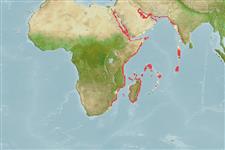Common names from other countries
>
Kurtiformes (Nurseryfishes, cardinalfishes.) >
Apogonidae (Cardinalfishes) > Apogoninae
Etymology: Taeniamia: Name from feminine Latin noun 'taenia' meaning ribbon or band; and feminine Greek noun 'Amia' meaning a fish, often used with cardinalfishes genera. Here as Taeniamia referring to the vertical wide bars and near vertical to curved narrow bars as lines on most of the species in this genus..
More on author: Cuvier.
Environment: milieu / climate zone / depth range / distribution range
Ecologie
marien rifbewoner; diepte 1 - 20 m (Ref. 54391). Tropical
Western Indian Ocean: known only from the Red Sea. Reports outside this area are misidentifications of several other species, including bleekeri, flavofasciata, fucata, macroptera, and mozambiquensis.
Grootte / Gewicht / Leeftijd
Maturity: Lm ? range ? - ? cm
Max length : 10.3 cm TL mannelijk / geslacht onbekend; (Ref. 7340)
Dorsale stekels (totaal) : 7; Dorsale zachte stralen (totaal) : 9; Anale stekels: 2; Anale zachte stralen: 12 - 14. Diagnosis: Rays: dorsal VI + I,9; anal II,12-14; pectoral rays 14 (rarely 13 or 15). Gill rakers 6-7 + 15-17. Lateral-line scales 25+3-4. Median predorsal scales 5-7. Body depth 2.4-2.6 in SL; body width 2.3-2.4 in body depth; eye diameter 2.7-2.8 in head length; first dorsal spine 1.85-2.4 in second spine; second dorsal spine 2.4-3.0, and third dorsal spine 2.4-2.9 in head length; spine of second dorsal fin 2.3-2.8, and second anal spine 2.7-3.0 in head length; pelvic-fin length 4.7-5.1 and caudal-peduncle length 5.0-5.35 in SL; distance from insertion of pelvic spine to anal-fin origin 4.25-4.6 in SL. Usually 1-4 small teeth present on median basilingual ridge. Posterior preopercular edge completely serrate, or nearly so; ventral edge serrate on posterior half. Scaly sheath along anal-fin base well developed (Ref. 54391).
Schools with other Archamia species in coral reef lagoons (Ref. 559). Cryptic, hiding in dark crevices and caves in reefs during the day (Ref. 54391).
Levenscyclus en paargedrag
Maturities | Voortplanting | Spawnings | Egg(s) | Fecundities | Larven
Are mouthbrooders (Ref. 240). Distinct pairing during courtship and spawning (Ref. 205).
Gon, O. and J.E. Randall, 2003. Revision of the Indo-Pacific cardinalfish genus Archamia (Perciformes: Apogonidae), with description of a new species. Indo-Pac. Fish. (35):49 p. (Ref. 54391)
Status op de Rode Lijst van het IUCN (Ref. 130435)
CITES (Ref. 128078)
Not Evaluated
Gevaar voor de mens
Harmless
Gebruik door de mens
Visserij: van geen belang
Tools
Speciale rapporten
Download XML
Internetbronnen
Estimates based on models
Preferred temperature (Ref.
115969): 24.7 - 28.8, mean 27 (based on 121 cells).
Fylogenetische diversiteitsindex (Ref.
82804): PD
50 = 0.5001 [Uniqueness, from 0.5 = low to 2.0 = high].
Bayesian length-weight: a=0.01148 (0.00715 - 0.01844), b=3.04 (2.90 - 3.18), in cm Total Length, based on LWR estimates for this species & (Sub)family-body (Ref.
93245).
Trofisch niveau (Ref.
69278): 3.5 ±0.50 se; based on food items.
Weerstandsvermogen (Ref.
120179): Hoog, minimale populatieverdubbelingstijd minder dan 15 maanden (Preliminary K or Fecundity.).
Fishing Vulnerability (Ref.
59153): Low vulnerability (10 of 100).
